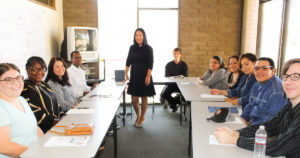
Across California, workforce development boards meet local employment needs while also helping workers get good-paying jobs. Photo courtesy of California Workforce Association
BY: THEA ROOD
California’s local workforce boards and a Sacramento-based nonprofit help people find good-paying jobs—and solve bigger social problems at the same time
Matching a local worker with a local business seems straightforward enough. But this seemingly simple act has ripple effects that can change an individual’s life, build a family’s generational wealth, and help end historical inequities. It can also impact the regional and state economy as more workers—and more business owners—choose to stay here.
“We are communities made up of people, people who need the best opportunity to buy a home and send their kids to college,” says Adam Peck, the executive director of the Workforce Investment Board in Tulare County. “And the magic is there are businesses that could grow if they had skilled workers.”
How it works
A statewide nonprofit, the California Workforce Association, where Peck is also the legislative committee chair, is focused on making these matches happen. For nearly 30 years, it has amplified the 45 local workforce development boards in their very targeted efforts.
“The primary theme of the workforce development boards is to make sure businesses have the skilled workers they need and then make sure (people) can be those skilled workers,” Peck explains. “Some are ready; (they) just need to have a job. Others have barriers.”
Barriers might include disabilities, limited English or outdated skills. But no matter where job-seekers land on the continuum, they can access career coaching and workshops at local job centers—at no cost. Workforce development boards also work closely with adult education programs, community colleges and private schools where people can get more in-depth training—and be assured a good local job awaits.
How can that guarantee happen? Not by accident. Each local board is deeply embedded in its unique community and honed in on specific business needs.
“If you’ve seen one workforce development board, you’ve seen one workforce development board—they’re all different,” says Peck. In fact, the 45-board system was designed to match the wide diversity of California, with its large urban areas, small rural communities and industries that range from ports to agriculture to forestry.
Predicting Supply and Demand
CWA also gauges the job market by working with its partner, the California Association of Local Economic Development (CALED), which identifies and helps attract new industry.
Peck’s CWA colleague, executive director Bob Lanter, gives the example of Zero Emission Vehicles, which first meant finding skilled workers for bus manufacturers in Los Angeles County, and now require skilled mechanics who can service e-buses—purchased by local transit systems and school districts—up and down the state. There also is a need for both lithium mining and producing lithium batteries.
“It really starts local, as a company comes in, and then the jobs go to communities, cities, counties. It’s where you start to build wealth, generational wealth, bringing jobs to neighborhoods that don’t normally get them,” says Lanter.
CALED executive director Gurbax Sahota says she believes local workforce boards are critical to understanding the real-time, constantly changing needs of local employment.
“Whether it is through layoff aversion programs, professional training or helping employers find the right skilled workforce, local workforce boards contribute to a community’s economic development efforts in creating opportunity for all residents,” Sahota says. “CWA is a valued partner for information on understanding key workforce opportunities, challenges and trends. Bob and his team understand and value economic development and work with us to share model practices on how economic developers and workforce development boards can work together.”
Another partner, Burning Glass Institute, collects data from websites like Indeed and Monster. “What they’re able to to do is talk to people like us about skills that are in demand and what kind of training we might be missing,” says Lanter.
In West Sacramento, for example, Burning Glass data can show what skills job-seekers in that area have and what jobs are available there, revealing any skills gaps. With this kind of fine-tuning, 90-minute commutes can be mitigated, as well as bigger issues, like making sure people of color and people living in poverty obtain the skills that are needed to get high-quality jobs in their communities.
“It’s exciting to watch CWA and its members take that to another level—no 90-minute commute can affect a worker’s family, her ability to be with her kids, etc.,” says Matt Sigelman, president of Burning Glass Institute and chair of Emsi Burning Glass. “And the tragedy is talent and opportunity are only a few skills apart. Many people are stuck in a poverty trap, cycling from one low-paid job to another. But if we help that worker achieve a couple of skills, much higher-paying jobs are available to them, and that’s a change for their entire family.”
Using the information in real time
Together, the localized workforce development boards and the statewide association have an agility that can react quickly to market fluctuations ranging from the 2008 Great Recession to the COVID pandemic now. They also are able to identify trends that are critical to making those employer-employee matches, which may not just be about money.
“We’re finding workers (now) are connecting to businesses who give them remote work, predictable scheduling, child care and tuition assistance,” says Lanter. “And where CWA comes in is to tell the state, ‘We have a hand on the pulse of Main Street California. Up and down the state, here’s what our members are doing that is working.’”
Questions? Contact CWA at calworkforce.org.
